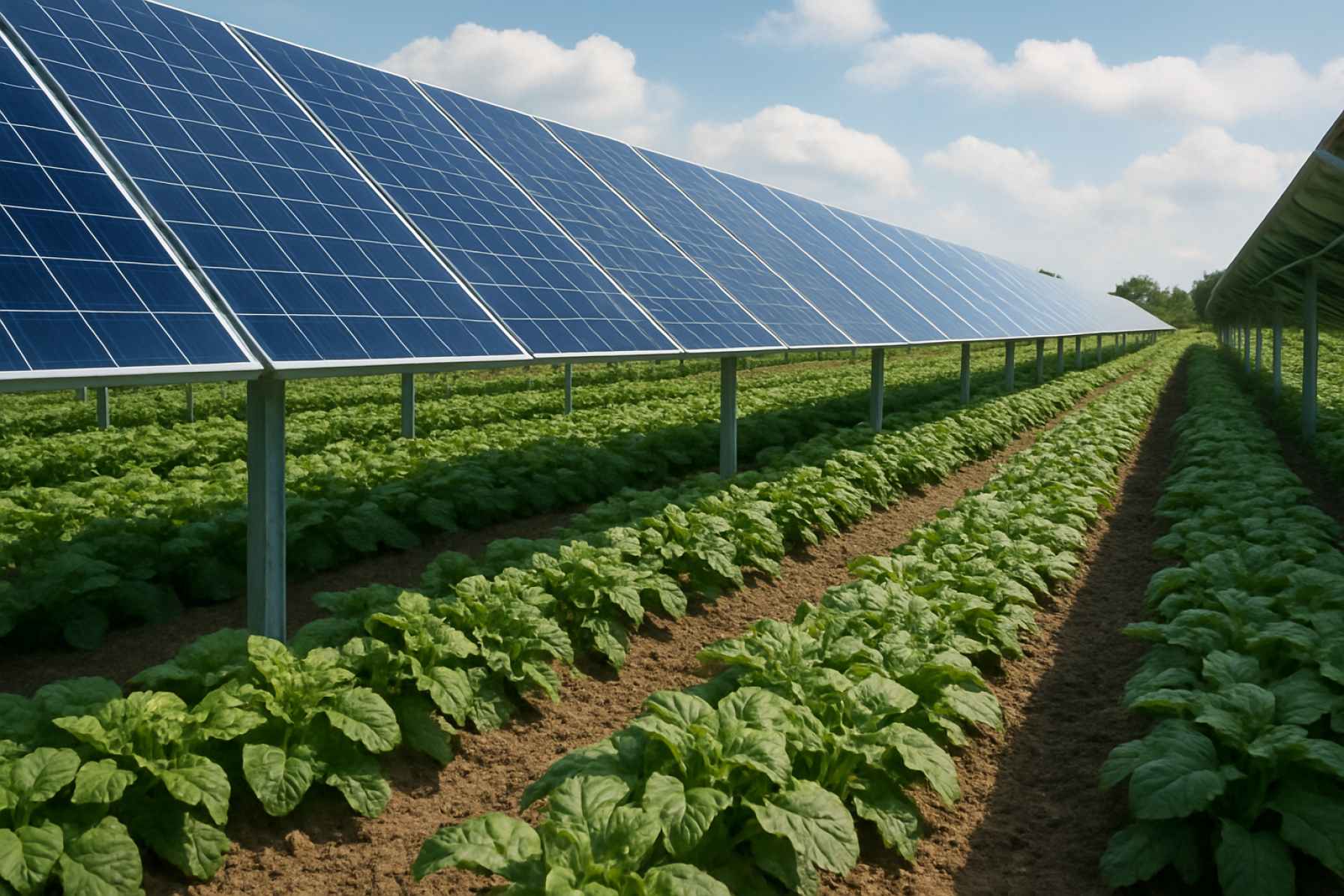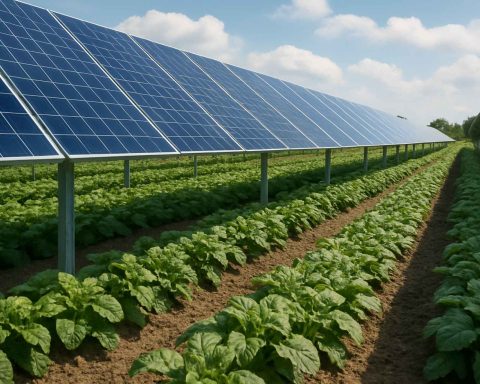Agrovoltaic Systems Integration Market Report 2025: In-Depth Analysis of Growth Drivers, Technology Innovations, and Regional Opportunities. Explore Key Trends, Forecasts, and Strategic Insights for Stakeholders.
- Executive Summary & Market Overview
- Key Technology Trends in Agrovoltaic Systems Integration
- Competitive Landscape and Leading Players
- Market Growth Forecasts (2025–2030): CAGR, Revenue, and Volume Analysis
- Regional Analysis: Market Dynamics by Geography
- Future Outlook: Emerging Applications and Investment Opportunities
- Challenges, Risks, and Strategic Opportunities
- Sources & References
Executive Summary & Market Overview
Agrovoltaic systems integration refers to the simultaneous use of land for both agricultural production and photovoltaic (solar power) energy generation. This dual-use approach addresses the growing global demand for renewable energy while preserving arable land for food production. In 2025, the agrovoltaic market is positioned at a critical juncture, driven by increasing land-use pressures, climate change adaptation needs, and ambitious renewable energy targets set by governments worldwide.
The global agrovoltaic market is experiencing robust growth, with Europe and Asia-Pacific leading in installed capacity and pilot projects. According to the International Energy Agency, the installed capacity of agrovoltaic systems surpassed 2.8 GW globally by the end of 2024, with projections indicating a compound annual growth rate (CAGR) exceeding 10% through 2030. Key drivers include policy incentives, such as the European Union’s Common Agricultural Policy reforms and China’s rural solar initiatives, which encourage the adoption of dual-use land strategies.
Market participants range from large energy utilities to specialized agritech startups. Companies like ENGIE and BayWa r.e. have launched significant agrovoltaic projects, integrating advanced solar tracking systems and crop-specific shading solutions. These innovations are designed to optimize both crop yields and energy output, addressing concerns about potential trade-offs between food and energy production.
The economic case for agrovoltaic integration is strengthening. According to a 2024 report by Wood Mackenzie, agrovoltaic systems can increase land productivity by up to 70% compared to single-use scenarios, while providing farmers with diversified revenue streams and greater resilience against climate variability. However, challenges remain, including regulatory uncertainty, high initial capital costs, and the need for site-specific agronomic research.
Looking ahead to 2025, the agrovoltaic sector is expected to benefit from increased investment, technological advancements, and supportive policy frameworks. As governments and industry stakeholders prioritize sustainable land management and decarbonization, agrovoltaic systems integration is poised to play a pivotal role in the global transition to a low-carbon, food-secure future.
Key Technology Trends in Agrovoltaic Systems Integration
Agrovoltaic systems integration refers to the simultaneous use of land for both agricultural production and photovoltaic (PV) energy generation. As the global demand for sustainable energy and food security intensifies, 2025 is witnessing a surge in innovative technology trends that are reshaping how agrovoltaic systems are designed, deployed, and managed.
One of the most significant trends is the adoption of advanced bifacial solar panels. These panels capture sunlight from both sides, increasing energy yield without expanding the land footprint. Their elevated mounting structures allow for optimal sunlight penetration to crops below, minimizing shading and supporting diverse crop types. According to International Energy Agency, bifacial modules are expected to account for over 35% of new utility-scale PV installations by 2025, with a notable share being deployed in agrovoltaic projects.
Another key trend is the integration of smart monitoring and control systems. Leveraging IoT sensors, AI-driven analytics, and real-time data platforms, these systems optimize both crop growth and energy production. For example, automated trackers adjust panel angles based on sunlight intensity and crop requirements, while soil moisture and microclimate sensors inform irrigation and shading strategies. Fraunhofer Institute for Solar Energy Systems reports that such digital solutions can boost land productivity by up to 60% compared to conventional single-use systems.
Modular and flexible mounting systems are also gaining traction. These allow for easy adaptation to different crop types, terrain, and farm machinery access. Innovations in lightweight materials and adjustable racking systems are reducing installation costs and enabling retrofitting on existing farmland. Companies like Enel Green Power and BayWa r.e. are piloting modular agrovoltaic arrays that can be rapidly deployed and reconfigured as agricultural needs evolve.
Finally, the trend toward crop-specific system design is accelerating. Research collaborations between agronomists and PV engineers are resulting in tailored solutions for high-value crops such as berries, leafy greens, and vineyards. These systems balance light transmission, panel spacing, and microclimate management to maximize both yields and energy output. According to International Renewable Energy Agency, such targeted integration is expected to drive a 20% CAGR in agrovoltaic installations through 2025.
Competitive Landscape and Leading Players
The competitive landscape for agrovoltaic systems integration in 2025 is characterized by a dynamic mix of established energy conglomerates, specialized solar technology firms, and innovative agricultural solution providers. As the dual-use land model gains traction, companies are racing to develop scalable, efficient, and farmer-friendly solutions that maximize both crop yield and solar energy generation.
European players are at the forefront, driven by supportive regulatory frameworks and ambitious renewable energy targets. BayWa r.e. has emerged as a market leader, leveraging its expertise in both solar project development and agricultural supply chains. The company’s pilot projects in Germany, France, and the Netherlands have set benchmarks for yield optimization and system design. Similarly, ENGIE and EDF Renewables are expanding their agrovoltaic portfolios, often in partnership with local cooperatives and research institutions.
In Asia, particularly Japan and China, agrovoltaic adoption is accelerating due to land scarcity and government incentives. Sharp Corporation and Trina Solar are notable for their integration of advanced bifacial modules and smart tracking systems tailored for agricultural compatibility. These firms are collaborating with agritech startups to refine crop selection and microclimate management under solar arrays.
The United States market is witnessing increased activity from both solar developers and agricultural equipment manufacturers. Nextracker and First Solar are piloting agrovoltaic projects in California and the Midwest, focusing on water conservation and soil health. Meanwhile, John Deere is exploring machinery adaptations for solar-integrated fields, signaling a convergence of agri-mechanical and renewable energy sectors.
- Key competitive factors include system adaptability to diverse crops, ease of installation, long-term maintenance, and proven yield benefits.
- Strategic partnerships between solar firms, agricultural cooperatives, and research bodies are critical for market penetration and technology validation.
- Emerging players are differentiating through digital platforms for monitoring, AI-driven crop management, and modular system designs.
Overall, the agrovoltaic systems integration market in 2025 is marked by rapid innovation, cross-sector collaboration, and a growing emphasis on localized solutions to address both energy and food security challenges.
Market Growth Forecasts (2025–2030): CAGR, Revenue, and Volume Analysis
The global agrovoltaic systems integration market is poised for robust growth between 2025 and 2030, driven by increasing demand for sustainable agricultural practices and renewable energy solutions. According to projections by Wood Mackenzie and International Energy Agency (IEA), the market is expected to register a compound annual growth rate (CAGR) of approximately 12% during this period. This growth is underpinned by supportive government policies, rising land-use efficiency concerns, and the dual benefits of energy generation and crop yield optimization.
Revenue from agrovoltaic systems integration is forecasted to reach USD 5.2 billion by 2030, up from an estimated USD 2.6 billion in 2025. This doubling in market size reflects both the expansion of pilot projects into large-scale commercial deployments and the entry of new players, particularly in Europe, North America, and Asia-Pacific. The European Union’s Green Deal and the U.S. Department of Energy’s investments in agrivoltaics are expected to be significant catalysts for regional market acceleration (European Commission, U.S. Department of Energy).
In terms of volume, the cumulative installed capacity of agrovoltaic systems is projected to surpass 18 GW by 2030, compared to approximately 7 GW in 2025. This surge is attributed to the scaling up of projects in countries such as France, Germany, China, and Japan, where land scarcity and food security are critical issues (IEA Photovoltaic Power Systems Programme). The Asia-Pacific region is anticipated to lead in volume growth, with China and India investing heavily in integrated solar-agriculture initiatives.
Key market drivers include technological advancements in bifacial solar panels, improved mounting structures for minimal crop shading, and digital monitoring systems for optimizing both energy and agricultural outputs. However, challenges such as high initial capital costs and the need for tailored regulatory frameworks may temper the pace of adoption in certain regions (Fitch Solutions).
- CAGR (2025–2030): ~12%
- Revenue (2030): USD 5.2 billion
- Installed Capacity (2030): 18 GW+
Regional Analysis: Market Dynamics by Geography
The integration of agrovoltaic systems—where agricultural activities and photovoltaic (PV) energy generation coexist on the same land—is experiencing varied market dynamics across different geographies in 2025. Regional adoption is shaped by factors such as land availability, government incentives, energy demand, and agricultural practices.
Europe remains at the forefront of agrovoltaic integration, driven by ambitious renewable energy targets and supportive policy frameworks. Countries like France, Germany, and Italy have implemented pilot projects and subsidy schemes to encourage dual land use. The International Energy Agency notes that the European Union’s Common Agricultural Policy (CAP) and the Green Deal are catalyzing investments, with France’s “Plan France Relance” specifically allocating funds for agrovoltaic research and deployment. The region’s focus on sustainable agriculture and land preservation further accelerates market growth.
Asia-Pacific is witnessing rapid expansion, particularly in China, Japan, and South Korea. China’s government has prioritized agrovoltaics as part of its rural revitalization and decarbonization strategies, with large-scale projects in provinces like Shandong and Hebei. According to Wood Mackenzie, Japan’s limited arable land and high population density make agrovoltaics an attractive solution, with regulatory adjustments allowing farmers to maintain agricultural subsidies while installing PV systems. South Korea’s “RE3020” plan also incentivizes solar-agriculture integration, aiming to increase renewable energy’s share in the national mix.
- North America: The United States is seeing growing interest, especially in states like California, Arizona, and Massachusetts, where water scarcity and land competition are significant. The National Renewable Energy Laboratory (NREL) highlights ongoing research and demonstration projects, with some states offering grants and technical support for agrovoltaic pilots. However, regulatory uncertainty and fragmented land ownership slow broader adoption.
- Latin America: Brazil and Chile are emerging as key markets, leveraging abundant solar resources and large agricultural sectors. The International Renewable Energy Agency (IRENA) reports that agrovoltaic projects in these countries are often tied to rural electrification and sustainable farming initiatives.
- Middle East & Africa: Adoption is nascent but promising, particularly in arid regions where maximizing land productivity is critical. Pilot projects in Morocco and Egypt, supported by international development agencies, are demonstrating the viability of agrovoltaics for food and energy security.
In summary, while Europe and Asia-Pacific lead in policy-driven adoption, North America and Latin America are emerging as dynamic markets, and the Middle East & Africa are exploring agrovoltaics as a solution to unique regional challenges. The pace and scale of integration in 2025 will continue to reflect local policy, climate, and agricultural priorities.
Future Outlook: Emerging Applications and Investment Opportunities
The future outlook for agrovoltaic systems integration in 2025 is marked by accelerating innovation, expanding applications, and increasing investment interest. Agrovoltaics—the simultaneous use of land for both solar photovoltaic energy generation and agriculture—has moved beyond pilot projects to become a focal point for sustainable land management and energy transition strategies worldwide. As governments and private sector stakeholders intensify their commitments to decarbonization and food security, agrovoltaic systems are poised for significant growth.
Emerging applications are diversifying rapidly. Beyond traditional crop cultivation under solar panels, new models are being piloted for livestock grazing, aquaculture, and specialty crops such as berries and medicinal plants. In Europe, for example, large-scale projects are integrating advanced tracking systems and bifacial panels to optimize both crop yield and energy output, while in Asia, agrovoltaics is being adapted for rice paddies and high-value horticulture (International Energy Agency). These innovations are supported by digital monitoring tools and AI-driven analytics, which enable real-time optimization of microclimates and resource allocation.
Investment opportunities are expanding as regulatory frameworks mature and financial incentives become more attractive. The European Union’s Common Agricultural Policy now includes provisions for dual land use, and countries like France and Japan have introduced specific subsidies and streamlined permitting for agrovoltaic projects (European Climate Foundation). In the United States, the Department of Energy is funding research and demonstration projects to validate the economic and environmental benefits of agrovoltaics, spurring interest from institutional investors and agribusinesses (U.S. Department of Energy).
- Venture capital and private equity are increasingly targeting agrovoltaic startups focused on system integration, smart irrigation, and crop-specific panel design.
- Utilities and independent power producers are forming partnerships with agricultural cooperatives to deploy large-scale agrovoltaic arrays, particularly in regions facing land-use conflicts.
- Impact investors are drawn by the dual benefits of climate resilience and rural economic development, with blended finance models emerging to de-risk early-stage projects.
Looking ahead to 2025 and beyond, the convergence of policy support, technological innovation, and investor appetite is expected to drive the global agrovoltaic market toward multi-gigawatt scale deployments. This will unlock new revenue streams for farmers, enhance grid stability, and contribute to more resilient food-energy systems (International Renewable Energy Agency).
Challenges, Risks, and Strategic Opportunities
The integration of agrovoltaic systems—where agricultural production and photovoltaic (PV) energy generation coexist on the same land—presents a complex landscape of challenges, risks, and strategic opportunities as the sector matures in 2025. While the dual-use model promises increased land-use efficiency and diversified revenue streams, several hurdles must be addressed for widespread adoption.
Challenges and Risks
- Technical Complexity: Designing PV arrays that optimize both crop yield and energy output requires advanced modeling and site-specific customization. Inadequate system design can lead to suboptimal light distribution, negatively impacting crop productivity or energy generation (International Energy Agency).
- Economic Viability: High initial capital costs and uncertain long-term returns pose significant barriers, especially for smallholder farmers. The lack of standardized business models and limited access to tailored financing options further complicate project development (International Renewable Energy Agency).
- Regulatory and Policy Gaps: Many regions lack clear regulatory frameworks for agrovoltaics, leading to permitting delays and ambiguity around land-use classification, grid connection, and agricultural subsidies (European Commission).
- Operational Risks: Maintenance of PV panels in agricultural environments can be challenging due to dust, crop debris, and machinery movement. There is also a risk of conflict between agricultural and energy operations, particularly during planting and harvesting seasons.
Strategic Opportunities
- Land-Use Optimization: Agrovoltaics enables dual revenue streams from the same land parcel, which is particularly valuable in regions facing land scarcity or high land costs (Food and Agriculture Organization of the United Nations).
- Climate Resilience: PV panels can provide partial shading, reducing crop heat stress and water evaporation, thus supporting climate adaptation strategies for agriculture (National Renewable Energy Laboratory).
- Policy Momentum: Growing policy support for renewable energy and sustainable agriculture, especially in the EU and parts of Asia, is driving pilot projects and incentives for agrovoltaic adoption (International Energy Agency).
- Innovation in System Design: Advances in bifacial panels, adjustable mounting systems, and digital monitoring are improving the feasibility and performance of agrovoltaic installations (Wood Mackenzie).
In 2025, the successful scaling of agrovoltaic systems will depend on addressing these challenges through targeted policy interventions, innovative financing, and continued technological development.
Sources & References
- International Energy Agency
- BayWa r.e.
- Wood Mackenzie
- Fraunhofer Institute for Solar Energy Systems
- Enel Green Power
- EDF Renewables
- Trina Solar
- Nextracker
- First Solar
- John Deere
- European Commission
- Fitch Solutions
- National Renewable Energy Laboratory (NREL)
- European Climate Foundation
- Food and Agriculture Organization of the United Nations










